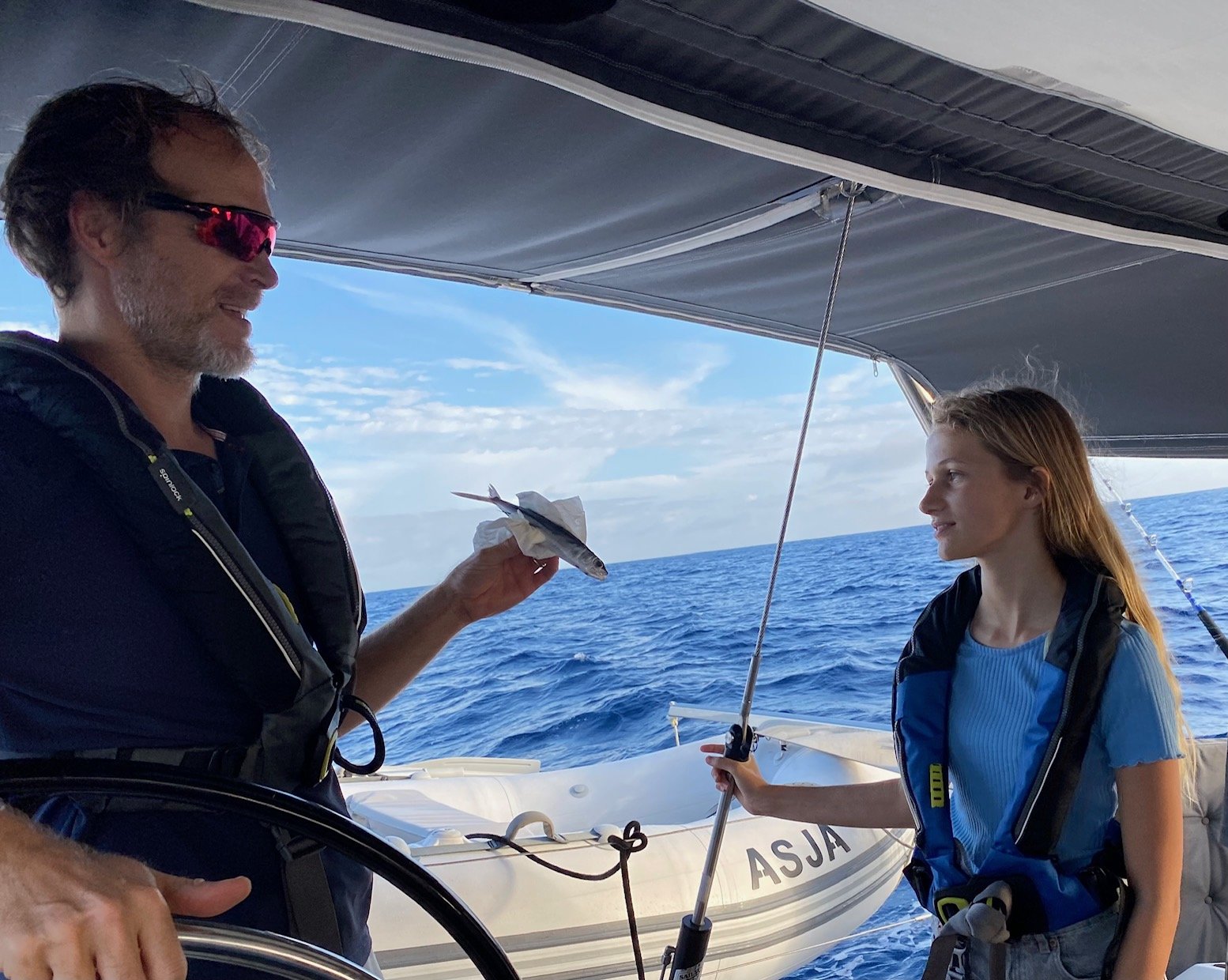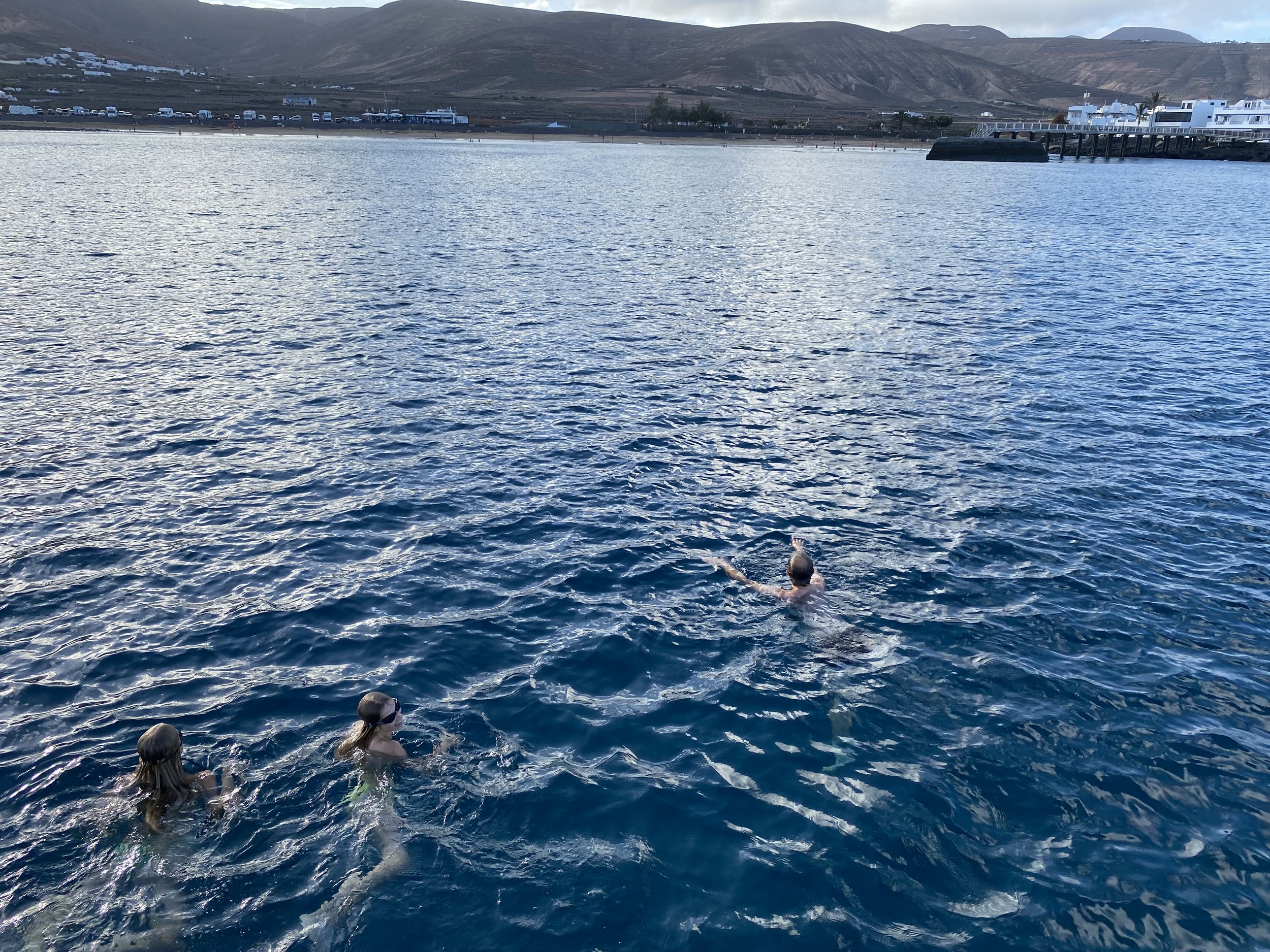Close Call
Ilhas desertas at night.
Madeira – Lanzarote
October 10, 2024, 8:30 p.m
Madeira’s lights start blurring into the hillsides until they look like fireflies. The sky is pitch black already and the water is, too. At 9.4 knots we rush through the Atlantic, close to the wind, on the port side. 28 knots, at altitudes over 30, put pressure on the sails. Wearing my safety vest in the cockpit, I brace my feet against the table. And my head against the bimini, which billows like a third sail on my neck.
We’re leaving the beautiful island of Madeira.
We've been following the weather forecasts for days. As sailors, ex-Hurricane Kirk and storm gusts have a new meaning for us. It made sense to start before new turbulences could reach Madeira. Into the darkness, why not. Our first night sails had been easy. By the end of August, the dreaded Bay of Biscay was surprisingly calm. The ride to Madeira was a bit rougher, the waves hit us unpleasantly from the side.
The wind is now pushing us towards the Ilhas Desertas, an uninhabited archipelago. The autopilot steers us east around the islands, into the lee.
an hour later
The kids try to sleep in their cabins. Daniel and I stay awake with crackers and share an energy drink. It’s not totally dark anymore. Whitecaps glow on waves that are bigger than us. From time to time, a wave washes over the bow or the stern. Our flag flutters as if it's about to fly away. The wind howls like in an old scary movie.
At 10 knots, we rush past Chão, the first of the three volcanic islands. 3.5 million year old rock fortresses. When we don't expect it, the moon appears from behind a cloud. It’s hanging in the sky like in a deck chair.
Sailing the ever-changing Atlantic.
October 11th, evening
At night, it was almost impossible to sleep. But the next day, the wind noticeably decreases. At a peaceful 15 knots, Asja plows through the water like clockwork. After one day, we have already covered 175 nautical miles. Our boat is still rolling a lot, so instead of cooking, I warm up tortillas in the microwave. In these conditions, small acts like opening the microwave door require timing and skill. Everything that is not fixed can fly towards me, slide or fall dawn.
We eat in stages on the starboard side in the cockpit. On the port side, you constantly have to hold onto everything or it slips onto your lap. Covered in jalapeño sauce, the omelet tastes much better than expected. Just in time for dinner, the sun sets in the sky in a dramatic spectacle.
“Now all that’s missing is a whale,” says Stella.
“Maybe there are some here. They just don’t show” I say.
“We would hear sperm whales. Their vocalizations are about 230 decibels,” says Louisa. Way louder than a gunshot or a rocket launch. Potentially even harmful for divers and snorkelers in the water. But what about sailors? Do the clicks with which the whales communicate and hunt penetrate the fiberglass walls of our ship?
We rather expect to meet whales here than any other crew. For hours, no boat has appeared on our radar and AIS. Not in a 2 nautical mile radius, not in a 5 mile radius, not even in a 10 mile radius. Daniel and I set our alarm clocks for night watch.
Lights appear in the darkness.
October 12, 2024, 2:30 am
The crackle of the radio wakes me up in my sleeping bag on deck.
“Motor Vessel Asja - what are your intentions?” asks a man’s voice.
Daniel is already awake. He has located the other ship as a red dot on the radar. But we don’t have any AIS data about the type of this vessel, position, speed and its closest approximation with us. The other ship doesn’t transmit any as it approaches. All we see is half a dozen illuminated floors in the distance. Given its dimensions, it could be a ferry. And since we are sailing, we have the right of way.
“This is sailing vessel Asja. We are sailing to Lanzarote.”
Our radio crackles. The man's voice says something, but only fragments of words reach us. After a while, he repeats:
“Motor vessel Asja, what are your intentions?” As if he hasn’t heard us, or hasn’t understood. Or doesn't want to.
“This is sailing vessel Asja. We are sailing to Lanzarote.”
Our opponent is ten times bigger than us. Its lights - those of a small town - advance to our port side. How unlikely it is to get this close in the open sea. It feels like I'm watching a movie in the cinema. But the giant boat is heading towards us unchecked. It could run over us at any moment.
“Give way”, I say.
At the same moment, Daniel starts the engine and steers the wheel for the last-minute maneuvre. Asja makes a 180 degree turn with standing sails. With only 11 knots of wind left, the goss and jib go along without protest. The anonymous giant passes. A smell wafts towards us as if they had opened the holding tanks.
In the night, a flying fish has jumped on Bord.
Later
After a day and 16 hours we reach the anchorage of La Arrieta, Lanzarote.
In front of a lunar landscape, permeated by lines of white houses, I drop the anchor. The water is clear enough to see the path of the chain. There is hardly any swell.
We call home. Sing happy birthday to my mother. Wash. Repair things. Write. Do homework. But: The encounter is still in our bones that evening. How quickly the situation became threatening for us. We discuss what we can improve in the future - communicate more clearly, including our course? Give way earlier? Luckily the problem wasn't with our AIS, it works perfectly. One thing is clear: meeting people in the middle of the sea was much more dangerous than squalls.
Crystal clear water at the anchorage.
In a bay with a popular sandy beach and restaurants (we didn't test)
Easy anchoring on sand
Not overcrowded
Wonderfully clear water invites you to swim
We had two quiet nights in a northwesterly location





